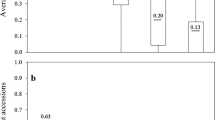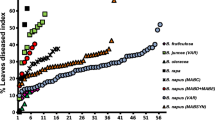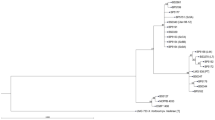Abstract
Some 154 Brassicaceae genotypes (78 Brassica napus, 38 B. carinata, 25 B. juncea, three Raphanus sativus, two each of Rapistrum rugosum and B. incana and one each of Crambe abyssinica, B. fruticulosa, Hirschfeldia incana, B. insularis, B. oleracea and Sinapis arvensis), were inoculated with a mixture of seven isolates of Hyaloperonospora brassicae to identify effective host resistances. Many highly resistant genotypes were identified, particularly R. sativus Krasnodar Market B (%Disease index 6.6) and Pegletta (%DI 9.0); B. carinata Tamn Rex-sel Green (%DI 7.6), BRA926/18 (%DI 9.7) and PI360884 (%DI 9.7); and B. juncea, Ringot1 (%DI 9.7). A further 13 B. carinata, seven B. juncea and single R. sativus (Boss) and B. incana (UPM6563) genotypes were also highly resistant (%DI 11.1), as were B. oleracea CPI106844 (%DI 14.6) and Crambe abyssinica (%DI 17.4). Almost all B. carinata and B. juncea genotypes showed high resistance (%DI 7.6–22.2). In contrast, B. napus genotypes showed wide ranging responses, from high resistance in SN-8 (%DI 22.2%) to extreme susceptibility in Hyola 450TT and Thunder TT (%DI 83.7, 95.5, respectively). R. rugosum, B. fruticulosa, H. incana and B. insularis genotypes ranged from moderately to highly susceptible (%DI 55.2–78.8). This study highlights the ready availability of very high levels of pathotype-independent resistance across diverse Brassicaceae to H. brassicae, particularly R. sativus, B. carinata, B. juncea, B. oleracea and C. abyssinica. Resistances identified can be utilized as sources of resistance in oilseed and vegetable Brassicaceae breeding programs and/or directly deployed as new varieties where downy mildew is prevalent.


Similar content being viewed by others
References
Bachofer, M. (2004). Molekularbiologische Populationsstudien an Plasmopara halstedii, dem Falschen Mehltau der Sonnenblume. Ph.D. thesis, University of Hohenheim, Stuttgart, Germany.
Barbetti, M. J., & Khangura, R. (2000). Fungal diseases of canola in Western Australia. Bulletin 4406, Agriculture Western Australia. 15pp.
Barbetti, M. J., Li, C. X., Garg, H., Li, H., Banga, S. K., Banga, S. S., Sandhu, P. S., Singh, R., Singh, D., Liu, S. Y., Gurung, A. M., & Salisbury, P. A. (2011). Host resistance in oilseed brassicas against Sclerotinia—Renewed hope for managing a recalcitrant pathogen. pp. 713-715, In: Proceedings of the 13th International Rapeseed Congress. Prague, Czech Republic.
Barbetti, M. J., Banga, S. S., & Salisbury, P. A. (2012). Challenges for crop production and management from pathogen biodiversity and diseases under current and future climate scenarios – Case study with oilseed brassicas. Field Crops Research, 127, 225–240.
Barbetti, M. J., Banga, S. K., Fu, T. D., Li, Y. C., Singh, D., Liu, S. Y., Ge, X. T., & Banga, S. S. (2014). Comparative genotype reactions to Sclerotinia sclerotiorum within breeding populations of Brassica napus and B. juncea from India and China. Euphytica, 197, 47–59.
Caravalho, T., & Monteiro, A. (1996). Preliminary study on the inheritance of resistance to downy mildew [Peronospora brassicae (Pers. Ex. Fr.)] at cotyledon stage in Tronchuda cabbage "Algarvia". Cruciferae Newsletter, 18, 104–105.
Carlier, J. D., Alabaça, C. A., Coelho, P. S., Monteiro, A. A., & Leitão, J. M. (2012). The downy mildew resistance locus Pp523 is located on chromosome C8 of Brassica oleracea L. Plant Breeding, 131, 170–175.
Carlsson, M., Bothmer, R. V., & Merker, A. (2004). Screening and evaluation of resistance to downy mildew (Peronospora brassicae) and clubroot (Plasmodiophora brassicae) in genetic resources of Brassica oleracea. Hereditas, 141, 293–300.
Cenis, J. L. (1992). Rapid extraction of fungal DNA for PCR amplification. Nucleic Acids Research, 20, 2380.
Channon, A. G. (1981). Downy mildew of brassicas. In D. M. Spencer (Ed.), The downy mildews (pp. 321–339). London: Academic Press.
Chattopadhyay, C., & Séguin-Swartz, G. (2005). Breeding for disease resistance in oilseed crops in India. Annual Review of Plant Pathology, 3, 101–142.
Coelho, P. S., Leckie, D., Bahcevandziev, K., Valerio, L., Monteiro, A., Astley, D., Crute, I. R., & Boukema, I. (1998). The relationship between cotyledon and adult plant resistance to downy mildew (Peronospora parasitica) in Brassica oleracea. Acta Horticulturae, (459), 335–342.
Coelho, P. S., Valério, L., & Monteiro, A. A. (2009). Leaf position, leaf age and plant age affect the expression of downy mildew resistance in Brassica oleracea. European Journal of Plant Pathology, 125, 179–188.
Coelho, P. S., Vicente, J. G., Monteiro, A. A., & Holub, E. B. (2012). Pathotypic diversity of Hyaloperonospora brassicae collected from Brassica oleracea. European Journal of Plant Pathology, 134, 763–771.
Coelho, P. S., Monteiro, A. A., Lopes, V. R., & Branca, F. (2018). New sources of resistance to downy mildew in a collection of wild and cultivated brassicas. Proc. VII Int. Symp. on Brassicas. Eds ME Cartea, P Soengas and M Francisco. Acta Horticulturae 1202. ISHS.
Dickson, M. H., & Petzoldt, R. (1993). Plant age and isolate source affect expression of downy mildew resistance in broccoli. HortScience, 28, 730–731.
Dickson, M. H., & Petzoldt, R. (1996). Seedling of downy mildew resistance in B. oleracea. Cruciferae Newsletter, 18, 108.
Dixon, G. R. (2006). Origins and diversity of Brassica and its relatives. In G. R. Dixon (Ed.), Vegetable brassicas and related crucifers (pp. 1–33). Wallingford: CABI.
Eshraghi, L., Barbetti, M. J., Li, H., Danehloueipour, N., & Sivasithamparam, K. (2007). Resistance in oilseed rape (Brassica napus) and Indian mustard (Brassica juncea) to a mixture of Pseudocercosporella capsellae isolates from Western Australia. Field Crops Research, 101, 37–43.
Farnham, M., Wang, M., & Thomas, C. (2002). A single dominant gene for downy mildew resistance in broccoli. Euphytica, 128, 405–407.
Ge, X. T., Li, H., Han, S., Sivasithamparam, K., & Barbetti, M. J. (2008). Evaluation of Australian Brassica napus genotypes for resistance to the downy mildew pathogen, Hyaloperonospora parasitica. Australian Journal of Agricultural Research, 59, 1030–1034.
Ge, X. T., You, M. P., & Barbetti, M. J. (2015). Virulence differences among Sclerotinia sclerotiorum isolates determines host cotyledon resistance responses in Brassicaceae genotypes. European Journal of Plant Pathology, 143, 527–541.
Göker, M., Riethmüller, A., Voglmayr, H., Weiss, M., & Oberwinkler, F. (2004). Phylogeny of Hyaloperonospora based on nuclear ribosomal internal transcribed spacer sequences. Mycological Progress, 3, 83–94.
Göker, M., Voglmayr, H., Blázquez, G. G., & Oberwinkler, F. (2009). Species delimitation in downy mildews: The case of Hyaloperonospora in the light of nuclear ribosomal ITS and LSU sequences. Mycological Research, 113, 308–325.
Gunasinghe, N., You, M. P., Banga, S. S., & Barbetti, M. J. (2014). High level resistance to Pseudocercosporella capsellae offers new opportunities to deploy host resistance to effectively manage white leaf spot disease across major cruciferous crops. European Journal of Plant Pathology, 138, 873–890.
Gunasinghe, N., You, M. P., & Barbetti, M. J. (2016a). Phenotypic and genetic variation associated with the crucifer white leaf spot pathogen Pseudocercosporella capsellae, in Western Australia. Plant Pathology, 65, 205–217.
Gunasinghe, N., You, M. P., Li, X. X., Banga, S. S., & Barbetti, M. J. (2016b). New host resistances to Pseudocercosporella capsellae and implications for white leaf spot management in Brassicaceae crops. Crop Protection, 86, 69–76.
Hoser-Krauze, J., Lakowska-Ryk, E., & Antosik, J. (1991). Resistance to some Brassica oleracea L. plant introductions to downy mildew (Peronospora parasitica). Cruciferae Newsletter, 14, 144–145.
Hoser-Krauze, J., Lakowska-Ryk, E., & Antosik, J. (1995). The inheritance of broccoli (Brassica oleracea botrytis) leaf resistance to downy mildew – Peronospora parasitica (Pers. ex. Fr.). Journal of Applied Genetics, 36, 27–33.
Howlett, B., Ballinger, D., & Barbetti, M. J. (1999). Diseases of canola in Australia. In P. A. Salisbury, T. D. Potter, G. McDonald, & A. G. Green (Eds.), Canola in Australia: The first thirty years (pp. 47–52). Canberra: Organising Committee of the 10th International Rapeseed Congress.
Jensen, B. D., Hockenhull, J., & Munk, L. (1999a). Seedling and adult plant resistance to downy mildew (Peronospora parasitica) in cauliflower (Brassica oleracea convar. botrytis var. botrytis). Plant Pathology, 48, 604–612.
Jensen, B. D., Værbak, S., Munk, L., & Andersen, S. B. (1999b). Characterization and inheritance of partial resistance to downy mildew, Peronospora parasitica, in breeding material of broccoli, Brassica oleracea convar. botrytis var. italica. Plant Breeding, 118, 549–554.
Kaur, P., Sivasithamparam, K., Li, H., & Barbetti, M. J. (2011). Pre-inoculation with Hyaloperonospora parasitica reduces incubation period and increases severity of disease caused by Albugo candida in a Brassica juncea variety resistant to downy mildew. Journal of General Plant Pathology, 77, 101–106.
Kimber, D. (1981). Varieties. In C. Green (Ed.), Oilseed rape book (pp. 41–53). Cambridge: Cambridge Agricultural Publishing.
Li, H., Ge, X., Han, S., Sivasithamparam, K., & Barbetti, M. J. (2011). Histological responses of host and non-host plants to Hyaloperonospora parasitica. European Journal of Plant Pathology, 129, 221–232.
Lucas, J. A., Crute, I. R., Sherriff, C., & Gordon, P. L. (1988). The identification of a gene for race-specific resistance to Peronospora parasitica (downy mildew) in Brassica napus var. oleifera (oilseed rape). Plant Pathology, 37, 538–545.
McKinney, H. H. (1923). Influence of soil temperature and moisture on infection of wheat seedlings by Helminthosporium sativum. Journal of Agricultural Research, 26, 195–217.
Mehta, N. (2014). Epidemiology and forecasting for the management of rapeseed-mustard diseases. Journal Mycology and Plant Pathology, 44, 131–147.
Mohammed, A. E., You, M. P., & Barbetti, M. J. (2017). New resistances offer opportunity for effective management of the downy mildew (Hyaloperonospora parasitica) threat to canola. Crop and Pasture Science, 68, 234–242.
Mohammed, A. E., You, M. P., Al-lami, H. F. D., & Barbetti, M. J. (2018a). Pathotypes and phylogenetic variation determine downy mildew epidemics in Brassica spp. in Australia. Plant Pathology, 67, 1514–1527.
Mohammed, A. E., You, M. P., & Barbetti, M. J. (2018b). Temperature and plant age drive downy mildew disease epidemics on oilseed Brassica napus and B. juncea. European Journal of Plant Pathology, 151, 703–711.
Monteiro, A. A., Coelho, P. S., Bahcevandziev, K., & Valério, L. (2005). Inheritance of downy mildew resistance at cotyledon and adult-plant stages in ‘Couve Algarvia’ (Brassica oleracea var. tronchuda). Euphytica, 141, 85–92.
Moss, N. A., Crute, I. R., Lucas, J. A., & Gordon, P. L. (1988). Requirements for analysis of host species specificity in Peronospora parasitica (downy mildew). Cruciferae Newsletter, 13, 114–116.
Nashaat, N. I., & Awasthi, R. (1995). Evidence for differential resistance to Peronospora brassicae (downy mildew) in accessions of Brassica juncea (mustard) at the cotyledon stage. Journal of Phytopathology, 143, 157–159.
Nashaat, N. I., & Rawlinson, C.,. J. (1994). The response of oilseed rape (Brassica napus ssp. oleifera) accessions with different glucosinolate and erucic acid contents to four isolates of Peronospora parasitica (downy mildew) and the identification of new sources of resistance. Plant Pathology, 43, 278–285.
Nashaat, N. I., Heran, A., Mitchell, S. E., & Awasthi, R. P. (1997). New genes for resistance to downy mildew (Peronospora parasitica) in oilseed rape (Brassica napus ssp. oleifera). Plant Pathology, 46, 964–968.
Nashaat, N. I., Heran, A., Awasthi, R. P., & Kolte, S. J. (2004). Differential response and genes for resistance to Peronospora parasitica (downy mildew) in Brassica juncea (mustard). Plant Breeding, 123, 512–515.
Natti, J. J., Dickson, M. H., & Aktin, J. D. (1967). Resistance of Brassica oleracea varieties to downy midew. Phytopathology, 57, 144–147.
Neik, T. X., Barbetti, M. J., & Batley, J. (2017). Current status and challenges in identifying disease resistance genes in Brassica napus. Frontiers in Plant Science, 8, 1788. https://doi.org/10.3389/fpls.2017.01788.
Saharan, G. S., & Krishnia, S. K. (2001). Multiple disease resistance in rapeseed and mustard. In S. Nagarajan & D. P. Singh (Eds.), Role of resistance in intensive agriculture (pp. 98–108). New Delhi: Kalyani.
Satou, M. (2000). Studies of physiological specialization of downy mildew of crucifers caused by Peronospora parasitica. Journal of General Plant Pathology, 66, 283.
Satou, M., & Fukumoto, F. (1996). The host range of downy mildew, Peronospora parasitica, from Brassica oleracea, cabbage and broccoli crops. Annals of the Phytopathological Society of Japan, 62, 393–396.
Silué, D., Nashaat, N. I., & Tirilly, Y. (1996). Differential responses of Brassica oleracea and B. rapa accesions to seven isolates of Peronospora parasitica at the cotyledon stage. Plant Disease, 80, 142–144.
Snedecor, G. W., & Cochran, W. G. (1989). Statistical methods, 8th ed. Iowa State University Press, Ames, Iowa, U.S.A.
Spencer-Phillips, P. T., & Jeger, M. (Eds.). (2004). Advances in downy mildew research. New York: Springer-Verlag.
Sylvester-Bradley, R., & Makepeace, R. J. (1984). A code for stages of development in canola (Brassica napus L.). Aspects of Applied Biology, 6, 399–419.
Thines, M., & Kummer, V. (2013). Diversity and species boundaries in floricolous downy mildews. Mycological Progress, 12, 321–329.
Thompson, K. F., & Hughes, W. G. (1986). Breeding and varieties. In D. H. Scarisbrick & R. W. Daniels (Eds.), Oilseed rape (pp. 32–82). London: Collins.
Tribulato, A., Donzella, E., Sdouga, D., Lopes, V. R., & Branca, F. (2018). Bio-morphological characterization of Mediterranean wild and cultivated Brassica species. Proc. VII Int. Symp. on Brassicas. Eds ME Cartea, P Soengas and M Francisco. Acta Horticulturae 1202. ISHS.
Uloth, M. B., You, M. P., Finnegan, P. M., Banga, S. S., Banga, S. K., Sandhu, P. S., Yi, H., Salisbury, P. A., & Barbetti, M. J. (2013). New sources of resistance to Sclerotinia sclerotiorum for crucifer crops. Field Crops Research, 154, 40–52.
Uloth, M., You, M. P., Finnegan, P. M., Banga, S. S., Yi, H., & Barbetti, M. J. (2014). Seedling resistance to Sclerotinia sclerotiorum as expressed across diverse cruciferous species. Plant Disease, 98, 184–190.
Van de Wouw, A. P., Idnurm, A., Davidson, J. A., Sprague, S. J., Khangura, R. K., Ware, A. H., Lindbeck, K. D., & Marcroft, S. J. (2016). Fungal diseases of canola in Australia: Identification of trends, threats and potential therapies. Australasian Plant Pathology, 45, 415–423.
Vicente, J. G., Gunn, N. D., Bailey, L., Pink, D. A. C., & Holub, E. B. (2012). Genetics of resistance to downy mildew in Brassica oleracea and breeding towards durable disease control for UK vegetable production. Plant Pathology, 61, 600–609.
Wang, M., Farnham, M. W., & Thomas, C. E. (2000). Phenotypic variation for downy mildew resistance among inbred broccoli. HortScience, 35, 925–929.
Wang, M., Farnham, M. W., & Thomas, C. E. (2001). Inheritance of true leaf stage downy mildew resistance in broccoli. Journal of the American Society for Horticultural Science, 126, 727–729.
Williams, P. H. (1985). Downy Mildew. Crucifer Genetics Cooperative (CRGC) resource book. Madison, WI, USA: Department of Plant Pathology, University of Wisconsin.
Zhang, S., Yu, S., Zhang, F., Si, L., Yu, Y., Zhao, X., Zhang, D., & Wang, W. (2012). Inheritance of downy mildew resistance at different developmental stages in Chinese cabbage via the leaf disk test. Horticulture, Environment and Biotechnology, 53, 397–403.
Acknowledgements
The first author is grateful to the scholarship from the University of Kufa in Iraq. The authors are grateful for some additional financial support of the Grains Research and Development Corporation (GRDC) as this work is aligned with part of the GRDC UWA170 project ‘Emerging foliar diseases of canola’. We are very grateful to commercial seed companies for provision of Australian varieties of B. napus and B. juncea and to Huang Yi, Oil Crops Research Institute, Chinese Academy of Agricultural Sciences, Wuhan, China, for seed of some Chinese genotypes. The exceptional technical support from Robert Creasy and Bill Piasini in the UWA Plant Growth Facilities is also gratefully acknowledged.
Author information
Authors and Affiliations
Corresponding author
Ethics declarations
Ethical approval
This research did not involve any animal and/or human participants.
Conflict of interest
The authors declare that they have no conflict of interests.
Rights and permissions
About this article
Cite this article
Mohammed, A.E., You, M.P., Banga, S.S. et al. Resistances to downy mildew (Hyaloperonospora brassicae) in diverse Brassicaceae offer new disease management opportunities for oilseed and vegetable crucifer industries. Eur J Plant Pathol 153, 915–929 (2019). https://doi.org/10.1007/s10658-018-01609-7
Accepted:
Published:
Issue Date:
DOI: https://doi.org/10.1007/s10658-018-01609-7




